|
Saunders Roe A.29 Cloud
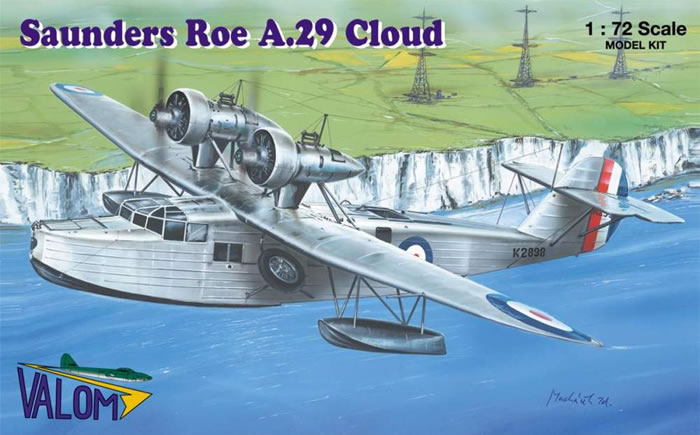
Valom, 1/72 scale
S u m m a r y : |
Catalogue Number: |
Valom Kit No. 72067 - Saunders Roe A.29 Cloud |
Scale: |
1/72 |
Contents & Media |
7 clear styrene and 128 grey styrene parts, 15 resin parts and 2 resin forms, 1 PE fret of with 48 parts, plus decals for 2 subjects. |
Price: |
Available online from: |
Hannants |
Modelimex |
Other Valom Stockists although the Cloud was not in stock at time of writing |
£31.17 |
€24.79 |
Squadron
Red Roo Models
Hobby Link Japan |
Review Type: |
First Look. |
Advantages: |
Nice detail, the forms to help shape the spoked wheels is a clever idea, good decals and painting guide. |
Disadvantages: |
Fine engraved lines all over the wings, which I think should instead appear smooth.
The instructions are vague in some areas. |
Conclusion: |
The first Saro Cloud kit, and very welcome too! I think a smooth wing would be more realistic, but in the greater scheme of things, it does not matter much. It needs care with assembly, as I doubt this kit will fall together, although a fine model will reward those who are patient.
I definitely recommended this kit. |
Reviewed by Mark Davies

Valom's 1/72 scale Saunders Roe A.29 Cloud is available online from Squadron.com
Background
The Saro Cloud first flew in July 1930. Civil customers accounted for four airframes whilst the RAF ordered one in 1931 and 16 more between 1932 and 1934.
The civil machines, known as A.19 Clouds, had a number of engine variations, and one had some significant airframe modifications whilst in service. I shall describe this and another of the more interesting variations in my opinion:
-
G-ABHG initially had three Armstrong-Siddely Lynx IVc engines in place of the twin Wright Whirlwind J6 configuration used previously. However, reversion to the twin layout occurred, but using Pratt & Whitney Wasp engines before its delivery. Perhaps the strangest alteration to this airframe was the fitting of a large supplementary wing above the engines on struts to provide extra lift and alter the airflow over the tail. This wing was much smaller in chord and span than the main wing, and approximated to the size of a sporting biplane’s upper wing. Alterations to the tail resulted in twin fins and rudders replacing the Cloud’s usual single arrangement. Named Flying Amo, BOAC eventually acquired it until its retirement in mid-1941.
-
The Czechoslovak shoe company, Bata, obtained another civil Cloud following a European sales tour (I can recall frequent TV adverts in 1970’s NZ for Bata Bullet sneakers!). This was the Cloud of Iona, which became OK-BAK after re-powering with Walter Pollux radials. It became a motor launch named Delfin lost its wing whilst in storage during WW2. It served in this boating capacity until at least the mid-sixties and possibly 1975. The Kbely Aircraft Museum in Prague now hold OK-BAK’s fuselage.
The first RAF Cloud flew in July 1931 following an Air Ministry order for a single machine that was the third Cloud built. Its specification was initially very similar to the civilian one, other than an increased fuel capacity, the ability to fit two 500-lb bomb racks and gun rings fore and aft. Trials with this machine led to several modifications including enlarged elevators, revised horn balances, Townend rings, stiffer engine mounts, strengthened empennage, and reinforcement of the hull bottom and floats. The Air Ministry placed an order in 1932 for sixteen machines using this revised military specification, and designated A.29 Clouds. The RAF used the machines for pilot and navigator training. Service introduction was 1933 and retirement occurred in 1939.
The Cloud handled well both in the air and on the water despite a rather ungainly appearance. It was an important type for Saro regardless of its small production number and comparatively short RAF service. It helped establish both a financial platform and reputation as a specialist flying-boat manufacturer.
I am unaware of any previous Saro Clouds in 1/72 scale, although surely at least one must have been kitted as a vac-form in the past. Many will therefore welcome the kit reviewed here and its sister boxing of civil versions, whether they are flying boat, golden age or RAF inter-war fans.
The kit comes in an atypical box for a Czech company, as Valom consistently uses the widely preferred top-opening variety. The contents are contained in a resealable cellophane bag, with the decals, PE fret, transparencies and various resin parts further contained in their own small bags. The instructions are typical for Valom, featuring a coloured painting and markings guide, an aircraft history in Czech and English, along with a parts map and diagrammatic assembly stages. Another and commendable Valom feature is that colour call-outs are cross-referenced to FS-595b and no less four model paint ranges (Humbrol, Agama, Model Master & Gunze Sangyo).
I found the parts to be typical for Czech limited-run kits. As with other Valom kits I have reviewed, I would say that quality falls somewhere between Special Hobby and Pavla for those familiar with these brands. Some flash is present but easily dealt with, and detail is generally well defined. Interestingly, the two sprues of seats, which come in their own bag, appear made from a different plastic and moulded to a slightly higher standard. Their tooling and sprue-gate style is different to Valom’s usual appearance.
Also unusual is that the main hull and fuselage halves are resin whilst the upper decking is styrene. I thought that this could have been to render a superior corrugated finish than would be the case with Valom’s injection moulding technique, but I decided to make some inquiries and find out for sure.
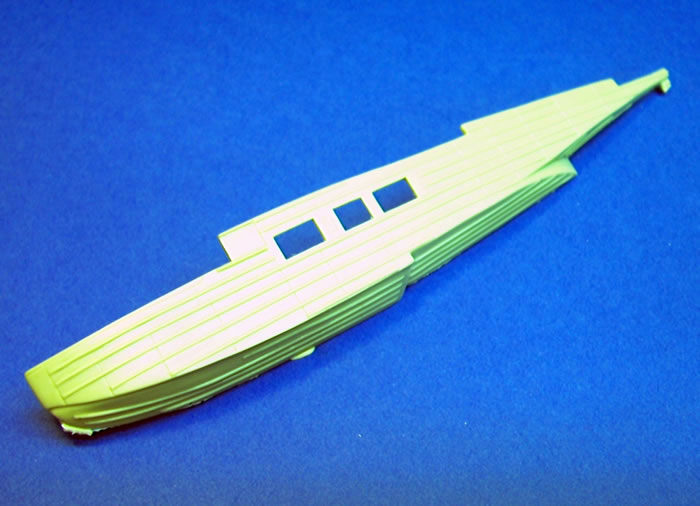
It seems that CMR had begun a Saro Cloud project a little ahead of Valom. When the two company owners (who are friends) became aware of the other’s plans they agreed that Valom would alone proceed as an all-resin kit would not be price-competitive with an injected one. CMR pointed out that injection moulding would not cater for the square section fuselage corrugations because they would need slightly tapered edges to release form the injection mould. Having persuaded Valom that only resin casting could render the fuselage accurately, CMR passed their fuselage pattern to them along with all of the research information they had garnered. They also passed across their patterns for the seats and control columns, which explains my earlier observation regarding their difference in style to the other Valom parts.
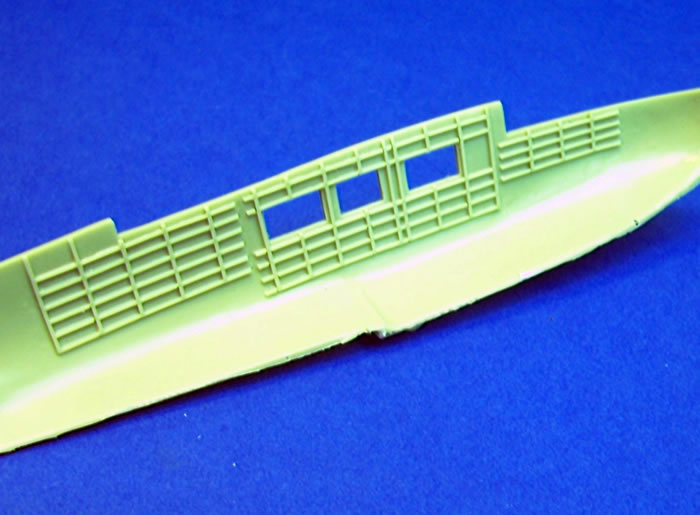
CMR Moulding & Casting produces the fuselage halves and the other resin parts, which all look good. (CMR recently split into two separate companies, CMR by Mark 1 researches, designs, masters and distributes resin kits, whilst CMR Moulding & Casting cast resin parts for CMR by Mark 1 as well as several other kit and accessory companies).
Surface detail on the corrugated fuselage and hull looks realistic, as does the representation of the fabric over tubular steel frame empennage. I am less convinced regarding the wing surfaces however.
Valom’s Cloud wing has quite light grooves scribed along presumably rib and spar lines. If the original had a metal wing these lines would be acceptable in kit form as engraved panel lines. However, it was not a metal wing. Saro used an Avro-designed wing based on Fokker practice (Avro having license-built the Fokker F.VII as the Avro 618 “Ten”). The wing formed a watertight unit capable of supporting a flooded fuselage and hull. This type of wing was essentially a thick wooden structure with a smooth plywood skin. I have studied numerous images of Clouds including some showing the wing surface very clearly, and it is extremely smooth in appearance (Click here and here for just two examples). I did find one image with very fine lines where the kit depicts them, and it is part of an on-line slideshow viewable here. I think the lines correspond with where the plywood skin fixes to the wing’s internal structure, or they could be tapelines standing out due to a lighting effect if doped fabric covered the ply wing (as some ply-covered airframes used this finishing method).
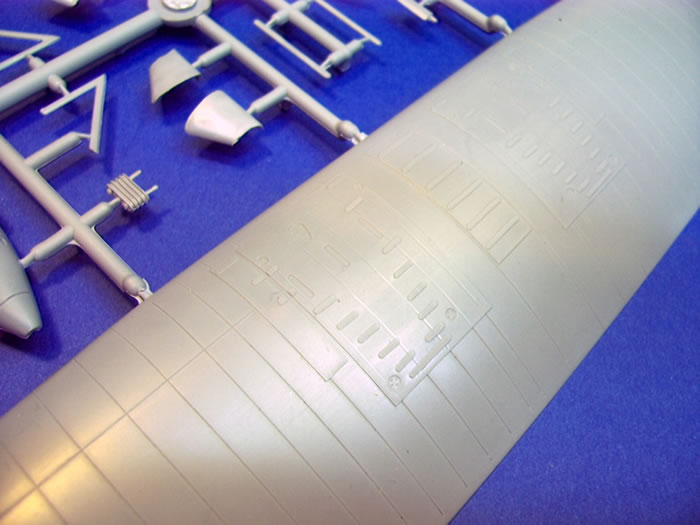
Regardless, I am certain that Valom’s inscribed lines give an unavoidably exaggerated appearance, and that they would better be extremely fine raised detail, if indeed the lines ought to be present at all. The engraved lines will consequently make for an annoying and time-consuming amount of filling and sanding in order to impart an authentic scale appearance. Despite this criticism, I can see many choosing to accept the lines as they are because they are very fine, and might be preferred to the plain appearance of an overall smooth wing. Whilst on the subject of engraved lines, it is worth mentioning that some aileron hinge-lines will befit from a quick re-scribe to better define them.
Assembly will hold few surprises, but it is fair to expect some fit challenges, as this is a limited run kit after all. The flight deck has adequate detail for the scale, using PE and acetate foils for the instrument panels, along with PE seatbelts and trim-wheels. Seats, rudder-pedals and control wheels are made of styrene. The instructions cover this assembly process near their front, whilst the drawing that guides the PE throttle placement is on the last pages following completion of the kit’s assembly! Behind the flight deck in the adjacent cabin is the navigator’s seat and table, followed in the next compartment by a chemical toilet. I think that very little of this cabin detail will be seen when the model is completed.
The fuselage/hull halves look as though they should be a good fit, but sometimes resin parts need some gentle adjustment under warm water to align correctly. A small door and window also need cutting out from the fuselage. I could see only one pinhole and this was on the resin keel.
The engines are a standout and rather ungainly feature of the real Cloud. Valom has made a nice job of the nacelles, but the cowlings, which will need a bit of cleaning up as they have a large cross-braced sprue across their insides and a lot of flash. The resin engines are good but lack pushrods, and the instructions make no mention of the need to scratch-build these. The engine support struts need to be located with care as the instructional diagrams are of little use here, although the painting and markings guide does provide a more useful indication of where the struts should fix to the wing. There are no locating holes for the engine struts, whilst there are for the float struts – Go figure! Resin oil coolers top off each engine, leaving just the resin propellers that look a bit slab-like, but then the originals were not all that refined or elegant either.
Fortunately, the instructions do a better job of illustrating the wing-float strut arrangement than they did for the engine struts. The undercarriage is very simple, although detailers may be interested in this image showing the cables associated with its elevation rather than retraction mechanism, as it remained fully exposed to the airstream after all. More challenging is the wheel hubs because they have spoked outer faces and inner metal ones with holes around the circumference. Valom provides styrene tyres, resin inner hubs and PE outer hubs. Two resin forms supplied with the kit shape the PE disks simulating the spoke hubs. These have male and female halves that will locate the PE disks and then dish them as the forms come together. Each PE rim has three cuts in its circumference to prevent buckling as the forms compress it
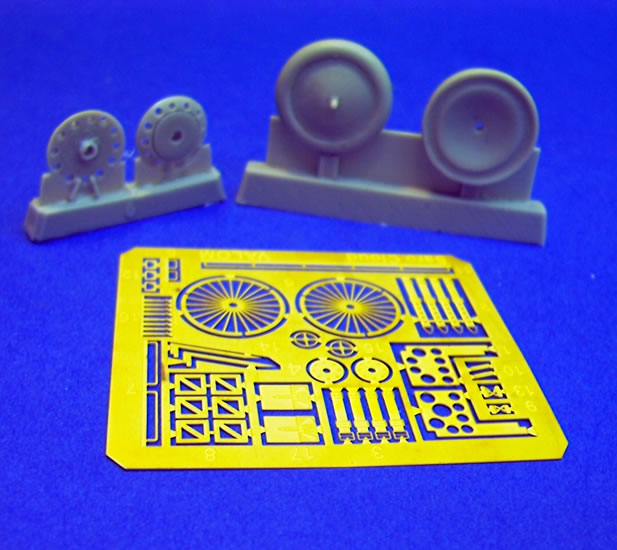
Not many parts remain. There is an acceptably clear canopy and various clear panels to glaze the windows.
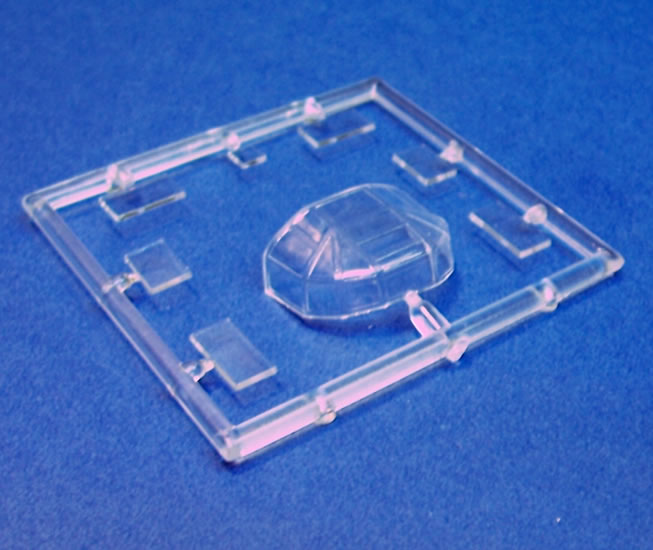
The empennage looks good and features separate elevators and rudder. Two quite noticeable antenna masts attach to the top of each engine nacelle and when rigged will add a lot of interest to the finished model. The PE fret provides three fuselage step surrounds, a couple of keel fixtures, some boarding handles and two pitots. These last items may appear too flat for realism and require either fattening or scratch-built replacements.
The kit supplies two essentially similar decal options, with different serial numbers and the same paint scheme of overall aluminium.
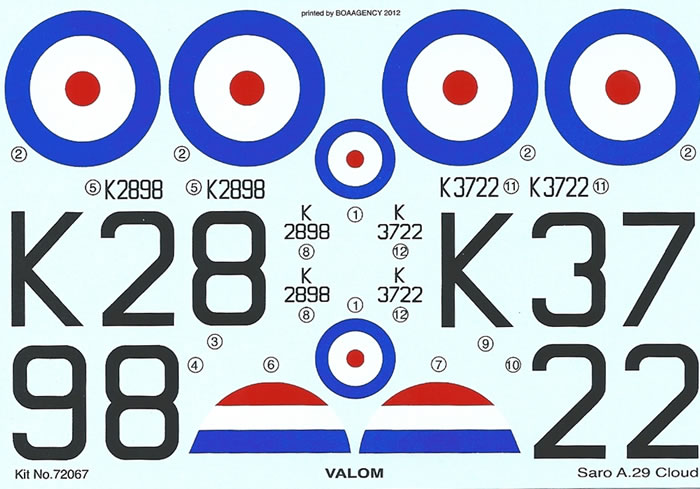
The decals have very good registration and suggest good opacity.
This is the first kit of the Saro Cloud to the best of my knowledge, and I am sure many will thank Valom for providing this boxing and the other civilian option. Congratulations are due to them for dealing with the subjects they have covered so far, and announced as future releases (like the Bristol Bombay!). They cannot hear modellers applaud of course, but if purchases express appreciation, then this trend of releases should presumably carry on.
I do feel it is time that Valom improved the quality of their instructions. Their colours and markings guides are good enough, and their detail-painting call-outs are better than most, especially with cross-referencing to several paint ranges. Nevertheless, some of their assembly diagrams convey little more than the obvious, e.g. in the Cloud’s case, that the engine assemblies go on top of the wing, but with very little guidance to exactly whereabouts. Not much is required, just a general “polishing up” and more thought towards helping the builder.
My discussion of the fine lines on the wings is lengthier than perhaps their significance warrants, as after all surface detail is at best a simulation or representation of the real thing. Perhaps the kit’s fine engraved lines are no less realistic than similar ones used on metal-winged subjects to represent overlapped panel lines. I trust this puts my critique in perspective; I would not want it regarded as an obstacle to finishing a nice model from this kit. This said, I still think a smooth wing in this scale would be more realistic.
Still, I doubt that this will be easy build. In part because of the subject’s layout with several strutted assemblies that need careful alignment, but also because the kit is limited run and Valom’s reputation for some fit issues. Despite this, a careful approach should reward the builder with a quite stunning model - Definitely recommended.
References:
-
British Flying Boats – Sutton Publishing, 2003
-
Aeroplane Monthly - July 1991
-
Avions - Issue 128, November 2003
-
Seawings.co.uk
Thanks to Valom for this review sample.
Review Text and Images Copyright © 2012 by Mark Davies
Page Created 30 April, 2012
Last updated
30 April, 2012
Back to HyperScale Main Page
Back to Reviews Page

|
